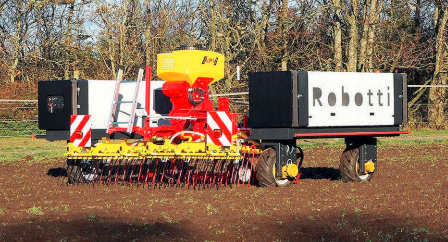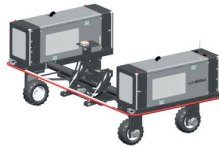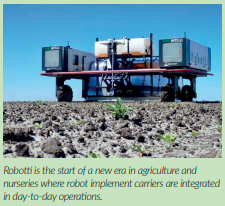Written by Chris Fellows based on information from AgroIntelli

After six years of intensive work, the new generation of Robotti, the autonomous implement carrier, celebrated its world premiere at Agritechnica last year amongst as lot of other robot technology. Built by Denmark’s AgroIntelli, it’s among the first autonomous implement carriers of its kind on the market and the way they have approached farming problems is certainly interesting.
The Robotti 150D is a versatile, autonomous implement carrier, with the power of a medium-sized tractor, but without a driver. Robotti is one of the first usable robots that can be used for harrowing, sowing, mechanical weeding, spraying and so on. Outputs of up to 3ha/hr are possible, depending on the task being carried out.
“With Robotti, we are at the start of a new agri-tech era in agriculture and horticulture where autonomous implement carriers become commercially sustainable and can be integrated into daily operations,” AgroIntelli sales director, Henrik Lynge Jacobsen, said.

“Timeliness, uniformity, time savings and sustainability are the major arguments for acquiring Robotti. For example, it is lighter and the soil can carry it as sooner, helping the farmer optimise sowing time.”
Robotti is equipped as standard with a laser scanner, camera and RTK/GPS, which provides precision of +/-2cm. AgroIntelli’s Robotti 150D is an evolution of the unique, autonomous concept that the company has tested during the past year with good results. These results have now been incorporated into the new model for 2020. It is larger and more capable, with bigger wheels and 150hp. A version with 75hp, called Robotti 75S, will also be available. Among others, Robotti has already been sold to Wageningen, Ghent and Aarhus universities, where it’s part of experimental work within robottechnology.
The new large version is equipped with two 75hp Kubota diesel engines that provide plenty of power and good operating speed of up to 10km/hr. In addition, the hydraulics come with three double-acting outlets and one return outlet. It offers ample power to handle a variety of implements via its standard three-point linkage. With a full height of 92cm, Robotti can also work during crops’ later growth stages. The centre mounting and the even distribution of weight on the four traction wheels helps balance the power and efficiency. Robotti is 35-50 per cent lighter than a similar conventional tractor, significantly reducing soil compaction.
Precision and safety are high priority
Precision and safety are based on digital technology and are a high priority for AgroIntelli. Robotti is equipped with a laser scanner, camera and RTK/ GPS as standard. The security systems have built-in redundancy and function independently of each other.

As an option, Robotti can be equipped with a number of powerful software packages, including plant counting and weed intensity measuring in the form of “weed maps”. Work plans for Robotti are managed online, where the user can use existing GPS field maps or create new ones. A computer calculates the most effective route plan to minimise fuel consumption, but also to minimise structural damage to the soil.
The log function also controls the machine history, with detailed maps stored and documented for each job. Likewise, images and recordings from mounted cameras and sensors on the autonomous robot can be stored via the logging function. During development, it was important for AgroIntelli to let Robotti operate under realistic conditions. Therefore, it’s equipped with standard Kubota engines and reliable hydraulics for low operating costs ,and easy servicing and maintenance.
Robotti is being used profitable
Henrik Lynge Jacobsen said the company’s calculations show that it pays to invest in a complete Robotti solution with tools for growing potatoes compared to a similar investment in a conventional tractor with implements.
“We have calculated the cultivation of 100ha of potatoes annually for a fiveyear period,” he added. “With Robotti, the return on investment is 181 per cent versus 138 per cent for the conventional tractor solution. This is partly due to lower labour costs and higher dividends because of less structural damage in the field.
“The robots are ready, and now it’s up to the agricultural industry to adopt the new technology.”
How AgroIntelli are approaching solutions

Ole Green, CEO of Danish robotics company AgroIntelli, wants his solutions to be unique and not just replicate other ideas. Looking back at what has happened historically in farming helps his team do this, he even takes them to agricultural museums. He feels that modern day farmers have got detached from the soil itself, spending more time in tractor cabins, with air conditioning far away from the soil. Farmers of previous generations would have spent far more time walking their land.
Therefore they have taken the approach with Robotti to work with implements that already exist. Thus the robotic elements add valaue to the current equipment as opposed to simply replacing it. This is a similar concept to what Continental did and was written about in Direct Driller Issue 9. However Robotti is in a much bigger scale. You can see the machinery in action via the QR Code.
